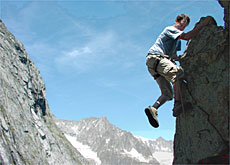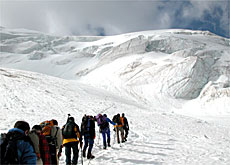Getting to grips with mountain iron

“Via Ferrata” or “iron ways” are becoming more and more popular in the Swiss Alps as non-climbers queue up to experience the thrill of a vertical ascent.
swissinfo followed the metal rungs and cables to the top of a Via Ferrata in canton Valais to report on the mountain routes, which are disliked by environmentalists.
We made our way to the wild Baltschieder Valley, following an ancient water channel hewn out of the rock.
After about an hour, mountain guide Hans-Christian Leiggener pointed to the sheer cliff to our left. “That’s where we are going,” he said. “Straight up.”
We had gently gained a couple of hundred metres in altitude since entering the valley, but the final 1,000 metres were to be a no-nonsense vertical ascent, following a Via Ferrata.
Cables, rungs, metal ladders and bridges have been used to secure steep and inaccessible mountain routes since the middle of the 19th century.
Army troops expanded the network in the Italian Alps in the First World War, to haul supplies and position guns.
Wired Italy
The Italians have maintained their Via Ferrata, with about 150 routes in the Dolomites, South Tyrol and around Lake Garda.
They are more popular than ever, and Switzerland is now getting in on the act.
We strapped on climbing harnesses and Leiggener instructed us in the use of the two short lengths of rope attached at one end to our harnesses, and at the other to carabiner metal loops.
We clipped the carabiners to the cable bolted to the rocks, which leads all the way up the cliff.
Nudging our way along, we grasped for natural hand and footholds, stepping onto iron rungs where the rock was smooth or overhanging, and sometimes pulling desperately on the cable itself for support.
Attracting tourists
There are now a couple of dozen Via Ferrata in Switzerland, and even though some date back more than a century, most are recent additions to the Swiss Alps.
“It’s an important piece of the puzzle, designed to attract more tourists to the area,” Leiggener said.
But it is one of the very few pieces in the puzzle of Ausserberg, the village that guards the entrance to the valley.
It has a couple of hotels, a rustic lodge located on a ridge high above, and a mountain guide centre.
There has always been a trickle of visitors who came to explore the untamed wilderness of a valley where the slopes have never been scarred by ski lifts nor its streams dammed.
But since 1997 when the Via Ferrata opened in the Baltschieder Valley, about 500 people come each year just to climb the route.
Off-limits
The Swiss environmental organisation, Mountain Wilderness, claims the people of Ausserberg had no business erecting the Via Ferrata.
It is worried about the rapid expansion of cabled routes through fragile alpine eco-systems like this one in the Baltschieder Valley.
By its very nature the route is narrow and steep, and the fact that climbers cannot deviate from it offers some protection to the alpine plants and animals.
“The purpose of the Via Ferrata is to give access to landscapes not normally open to the public,” Leiggener said.
“Environmentalists would like the Alps to be off-limits for every kind of activity but without tourism, mountain villages couldn’t survive, so everybody would have to migrate to the cities,” he said.
Leiggener downplayed fears that Switzerland’s network could soon rival that of neighbouring Italy. He said there were no plans to build a second Via Ferrata in this wilderness he calls home.
“I’m not a really big fan of heavy metal,” he joked.
Screaming marmots
Continuing our ascent, we listened to a marmot’s shrill scream and took a well-deserved rest to watch an ibex scurry up a snowy slope.
Leiggener moved with ease ahead of us, pointing out orchids, alpine roses and gentian among the many alpine flowers in bloom, listing their medicinal properties and telling us which could sooth aching joints and heal cuts.
After an exhausting four-hour climb, we reached the top and were rewarded with a view of the whole valley stretched out below us.
swissinfo, Dale Bechtel in the Baltschieder Valley
Via Ferrata are mountain routes secured with steel cables, metal rungs and sometimes ladders or bridges.
There are now about two dozen dotted across the Swiss Alps.
They are known in German-speaking Switzerland as “Klettersteig” (climbing paths).
The routes range from relatively short with a lot of variety (ladders and bridges) to long and physically demanding (Baltschieder Valley).
Switzerland’s mountain guide centres (see related sites) offer Via Ferrata tours and equipment hire for inexperienced climbers.
Most centres have English-speaking guides.

In compliance with the JTI standards
More: SWI swissinfo.ch certified by the Journalism Trust Initiative


You can find an overview of ongoing debates with our journalists here . Please join us!
If you want to start a conversation about a topic raised in this article or want to report factual errors, email us at english@swissinfo.ch.